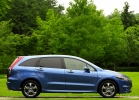Honda Stream test drive since 2006 minivan
Inch spores
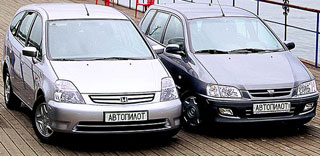 The compact minivan was originally conceived as a family car. The fact that its capabilities can be much wider shows the path traveled from Mitsubishi Space Star to Honda Stream.
The compact minivan was originally conceived as a family car. The fact that its capabilities can be much wider shows the path traveled from Mitsubishi Space Star to Honda Stream. We chose these two cars not by chance. Firstly, they both belong to the fashionable class of compact minivans in the world, that is, they have one concept. Secondly, both are built on the platform of the so-called class C (small average). Thirdly, Space Star has been living in the Russian market for three years, and Stream is the latest novelty. But from the point of view, they are at the opposite poles: Stream is more expensive for $ 9 thousand. So we decided to see how consumer and running qualities of machines justify this difference.
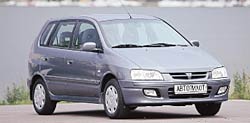
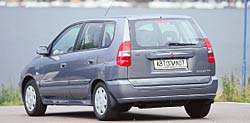
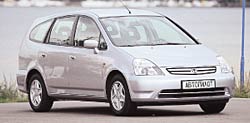
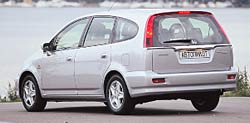
Wings or tail? Even with the most cursory look at the photo, it is easy to notice that Stream is longer. But not for the notorious $ 9 thousand, but exactly 52 centimeters that occur on its back. In height and width, the cars are almost identical. And the Honda base also has more, 22 cm. However, this quality is inherited from the Civic of the last, seventh generation, which in this parameter replays its classmates. As well as according to the original layout of parts under the bottom, the know-how Honda, which allows you to make the floor of the car completely flat.
Space Star is more conservative outside and in its external data closer to traditional station wagons. More precisely, to five -door hatchbacks. But the original moldings and the shape of the doors with stamping, crossing from the rear door to the wing, as well as plastic threshold lining still look more advantageous against the background of the smooth sides of Stream. However, the latter due to a sharply mowed hood-swing, a more hollow windshield and a smooth side line with an elongated oval of lateral glazing acquires a very energetic, even to some extent, a sports look.
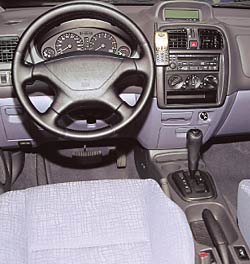
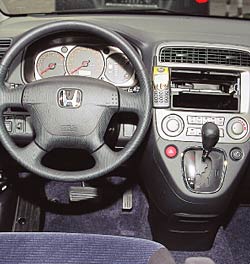
Necessary accessories. The main idea of \u200b\u200bcompactwane is in high functionality and the same convenience for the driver and passengers. Let's start with the driver. In this zone, the internal dimensions of both machines are the same. The cheaper Space Star is equipped, oddly enough, richer. Along with a hydraulic wiper, air conditioning, immobilizer, electric glasses and electric grinders and two front airbags in it, we found a two-stage heating of the front seats, an integrated audio system with a CD player and blocking the central castle of a special key from the inside. Another large multifunctional display, where the sinking temperature, time and storage margins are displayed. Stream proposes to choose and install the radio independently and does not indulge in all sorts of additional displays at all. He does not even have a traditional adjustment of the brightness of the instrument lighting. But there are two more side airbags, and the central lock is controlled from the key fob. And the fabric on the seats will be richer. True, we must pay tribute to Space Star, in the front of the cabin he has much larger than all sorts of niches and drawers, and the driver has even boxing boxes above the doorway.




LIVING SPACE. However, we will move to the passenger (it is baggage) zone. Here, leadership clearly belongs to Stream. In the Space Star, the rear seat can move back and forth 15 cm, its pillows and backs are folded separately in a traditional ratio of 60:40, and the backs of the rear seat have several tilt positions. Options for transforming the salon in Honda are able to hit the imagination. The seats of the second row are divided into two equal parts, which either move separately horizontally, or fold both in whole and in parts. The middle part of the back can be laid forward, and you get an armrest with two deep cup holders in it. And, of course, the main trump card Stream is the third row of seats (the same additional 52 cm of length). True, there is one but. When it is laid out, the trunk, as such, just disappears. But in a folded state, the seat is completely hidden in a special niche, forming a completely even floor. For some reason, the manufacturer does not advertise the volumes of the luggage compartment, but by eye, when all the seats are folded, it turns out at least two cubic meters. Only one question remains: who will ride the gallery? Most likely, only children. For the adult will require complex gymnastic exercises to get there, and the low ceiling will make him sit, bending in three deaths. And again the question arises: is it all additional money? A very big question. The multivariance of transformation is very convenient in a variety of situations, but probably every user himself will appreciate it.




Car disputes. Having adjusted the seat for itself, which in both machines has an adjustment of the inclination of the pillow, we note that in Mitsubishi this procedure is more convenient. Yes, the body, let's say, is better in this seat. The steering wheel is adjusted in height in both cases, only now the steering wheel itself in the Space Star is covered with skin. However, the rough plastic from which the Stream steering wheel is made in another: the diameter of the steering wheel is smaller, and it itself is more convenient. Now, if the rim was a little thicker, it would be completely wonderful.
Both cars are equipped with automatic checkpoints with the so -called manual mode. Both boxes, as evolves from the descriptions, have the ability to adapt to the driving style and allow the engine to slow down in automatic operation. This effect is more pronounced and noticeable in Stream, in Space Star it is somehow non-obvious. But the manual regime in both cases deserves praise. Up, transmissions switch only forcibly, which allows you to accelerate very dynamically, promoting the engine to maximum revolutions. When a checkpoint operating in manual mode is stopped, it automatically switches to the first gear. For compulsory gear switching, to slow down the engine, Honda reacts much more pronounced. The engine, as expected, roars, and the machine slows down noticeably. The Space Star box does not respond to the command until the revolutions fall to a safe, in her opinion, level. But what's interesting. In manual control mode, the difference in the accelerated dynamics between machines with such seemingly different engines is little noticeable. It is probably affected by an almost equal ratio of weight and power: in Space Star this figure is 10 kg, and in Stream - 9.1 kg per 1 hp. It turns out, 98 versus 154 hp. They are quite competitive. Naturally, to a certain limit: the supply of power and torque makes itself felt. If Stream quickly, evenly and without tension reaches 180 km/h and it is felt that this is not the limit, then Space Star clearly loses here. Actively maneuver on mitsubishi and sharply accelerate only in manual mode.
But in terms of comfort of suspension and maneuverability, it is almost not inferior and even surpasses Stream in some ways. Although in terms of controllability, stability and resistance to the rolls, the latter is clearly better.
 Pay for what? So, let's summarize. With Space Star, everything seems to be clear. An economical, convenient and practical family car with high functionality, the sum of consumer qualities of which is adequate to its Russian price. The level, so to speak, reasonable sufficiency. And Stream? Strange car. It seems to be almost the same family compactway. But with a claim. Request more on the driver than on the calm transportation of the family. Are its additional two passenger places and additional horses really standing (a more gentle option is possible - 1.7 liters with 125 hp) of those nine thousand dollars? In our opinion, there is rather no than yes. And although for this money you get a car not only to transport, but also to travel, as well as high technologies - this price seems clearly high against your no less titled classmates. Each extra Honda inch will cost the buyer $ 432.
Pay for what? So, let's summarize. With Space Star, everything seems to be clear. An economical, convenient and practical family car with high functionality, the sum of consumer qualities of which is adequate to its Russian price. The level, so to speak, reasonable sufficiency. And Stream? Strange car. It seems to be almost the same family compactway. But with a claim. Request more on the driver than on the calm transportation of the family. Are its additional two passenger places and additional horses really standing (a more gentle option is possible - 1.7 liters with 125 hp) of those nine thousand dollars? In our opinion, there is rather no than yes. And although for this money you get a car not only to transport, but also to travel, as well as high technologies - this price seems clearly high against your no less titled classmates. Each extra Honda inch will cost the buyer $ 432. Text Andrey Timofeev, photo Alexey Ilyin
Cars are provided by Autocon Motors, (095) 213-6195 (Honda), and Rolf Holding, (095) 785-1978 (Mitsubishi). Insurance is carried out by Ingosstrakh, (095) 956-5555.
Playing in phase
2001 for the Honda concern was a new reference point in the history of this company-a family of I-Series engines was launched into production. By 2005, they will be equipped with the entire automobile model range of the company.
The first model to receive a new I-VTEC engine was precisely Honda Stream. Technology I allows you to increase the power of a two -liter engine by 20 percent, and torque at average speeds by 10 percent, reducing the fuel consumption and harmful emissions by about 20 percent. The specifically declared fuel consumption of a 154-horsepower engine in mixed mode is 8.6 l/100 km, and the CO content in the exhaust is estimated at 204 g/km. The I engine I engine, compared to the engines of the previous generation, has become shorter, already easier to almost 13 kg.
The engine owes its excellent characteristics, first of all, the advanced system for changing the phases of gas distribution called VTC (Variable Timing Control). Unlike the traditional VTEC engine, the corner angle, the head of the intake valves, also changes in the new engine. In addition, the intake manifold is made of plastic and has changed automatically, depending on the load, the geometry of the tract. And the direction of rotation of the crankshaft goes clockwise.
Model/Modification Mitsubishi Space Star Honda Stream
The producer of the Netherlands of Japan
BODY
Number of doors/places 5/5 5/5-7
ENGINE
Basin type with electronic multi -point injection
The location in front is transversely
Working volume (cubic meter) 1584 1998
Number/location of cylinders 4/row
Cylinder diameter x Piston stroke (mm) 76x87.3 86x86
Power, kW (L.S.) at about./Min. 72 (98) at 5000 113 (154) at 6500
Max. torque (Nm at about./min.) 150 at 4000 186 at 4000
Gas distribution system/number of valves SOHC/16 DOHC/16
TRANSMISSION
Front front drive
Automatic gearbox 4-speed automatic 5-speed
SUSPENSION
Front independent, such as Mcphereson, on transverse levers, the transverse stability stabilizer Independent spring on triangular transverse levers, the reptile stabilizer
The rear independent multi -link spring, the transverse stability stabilizer is independent spring, on triangular levers with an additional transverse beam and a reptile stabilizer
STEERING
Type gear rack with an integral type
Min. Diameter of turn (m) 10.4 10.6
Brakes
Front disk ventilated
The rear disc
ABS electronic 4-channel with 4 sensors
Wheels
Tire size 185/65 R14 195/65 R15
Steel disks 5.5x14 6JX15
Dimensions/volumes/weight
Length/width/height (mm) 4030/1715/1515 4550/1695/1590
Wheel base (mm) 2500 2720
The track front/back (mm) 1475/1470 1470/1470
The volume of the fuel tank (L) 55 50
Equipped mass 1205 1590
Dynamic characteristics
Maximum speed (km/h) 171 190
Acceleration to 100 km/h (sec.) 14.5 10
Economy
Fuel consumption (l/100 km): city/highway 10.7/6.7 12/8
The price in Moscow is $ 18.8 thousand $ 27.5 thousand.
Source: "Autopilot"



